Data extracted in: July 2024.
Planned article update: December 2025.
Highlights
In 2023, 3.8% of people aged 16 years or over in the EU had an unmet need for a medical examination or treatment.
In 2023, 4.7% of people aged 16 years or over in the EU had an unmet need for a dental examination or treatment.
Share of people aged 16 years or over reporting unmet needs for medical examination or treatment, 2023
This article provides an overview of statistics related to unmet needs for medical and dental care among people in the European Union (EU). It presents a variety of reasons why needs for healthcare services are not met, for example because of financial reasons (too expensive), distance/transport (too far to travel) or timeliness (waiting lists); this information may be used to identify some of the principal limitations concerning access to health care.
The data come from EU statistics on income and living conditions (EU-SILC) and relate to the 2023 reference year. The EU-SILC survey collects data on unmet medical or dental care needs and the main reasons for these, forming the basis for 2 types of indicators.
- The 1st indicator relates to self-reported unmet needs for medical or dental examinations calculated as a percentage of all people (aged 16 years or over), including individuals who have not reported having any medical needs. It shows how widespread unmet needs are among the general population.
- The 2nd indicator, which relates to the same self-reported unmet needs, is expressed as a percentage of people (aged 16 years or over) who reported a medical need. It provides a more focused insight into access issues among those seeking care.
This article is 1 of a set of statistical articles on health status which forms part of Chapter 5 in an online publication, Health in the European Union – facts and figures.
Unmet needs for medical examination or treatment
In 2023, 3.8% of people aged 16 years or over in the EU had an unmet need for a medical examination or treatment
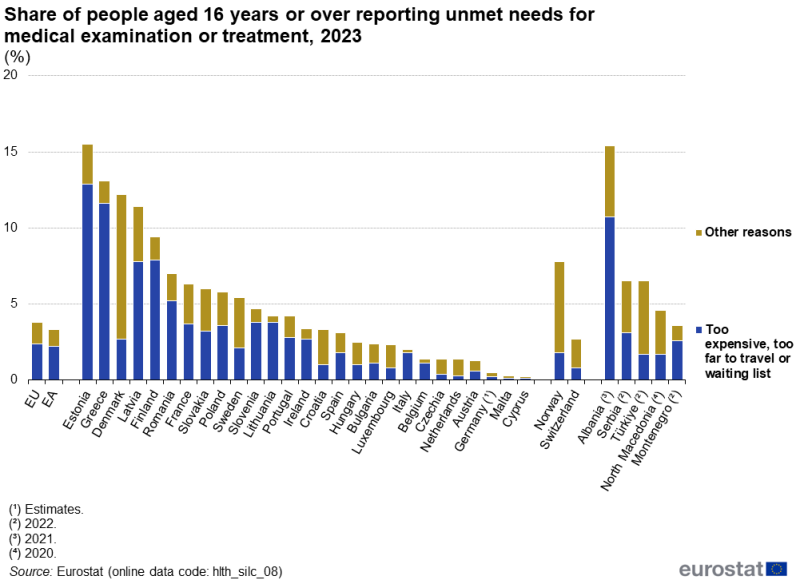
(%)
Source: Eurostat (hlth_silc_08)
In 2023, 3.8% of the people aged 16 years or over in the EU reported that they had unmet needs for a medical examination or treatment (hereafter referred to as medical care), a share that ranged from 0.2% in Cyprus, 0.3% in Malta and 0.5% in Germany (low reliability) up to 15.5% in Estonia. As regards reasons related to the organisation and functioning of health care services (too expensive, too far to travel or waiting lists), 2.4% of people in the EU reported they had unmet needs, a share that ranged from 0.1% in Cyprus and Malta up to 11.6% in Greece and 12.9% in Estonia – see Figure 1.
Being too expensive and waiting lists were the most common main reasons for unmet medical care needs in 2023
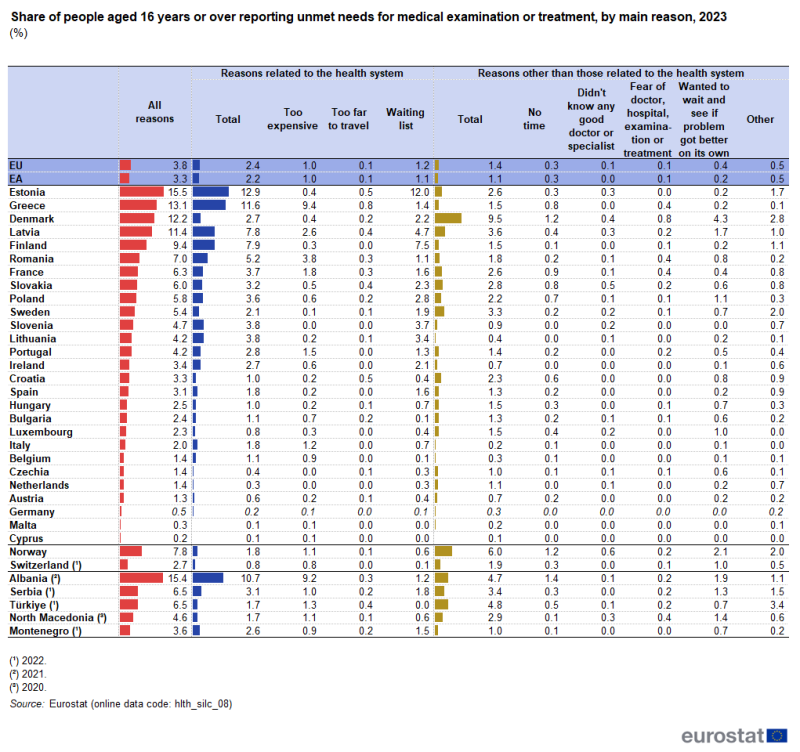
(%)
Source: Eurostat (hlth_silc_08)
In the EU, the 2 most common reasons for unmet needs for medical care in 2023 were because of waiting lists or that it was too expensive. Together these 2 reasons accounted for more than half of all people who reported an unmet need for medical care: as a share of all people (aged 16 years or over), this was 1.2% for waiting lists and 1.0% for reasons of being too expensive – see Table 1. The next most common main reasons given were wanting to see if the problem got better on its own (0.4% of people) and a lack of time (0.3%). Less common reasons included fear, not knowing a good doctor or specialist, or that it was too far to travel (all 0.1%). In addition to the specified main reasons, a further 0.5% of people indicated another (unspecified) reason for an unmet need for medical care.
A waiting list hindering medical care was the most frequent specific reason given for unmet needs for medical care in Estonia, Ireland, Spain, Latvia, Lithuania, the Netherlands, Austria, Poland, Slovenia, Slovakia, Finland and Sweden in 2023. In Hungary, this was the joint most frequent specific reason along with wanting to wait and see if the problem got better on its own while in Germany, it was the joint most frequent specific reason along with medical care being too expensive.
The expense of medical care was the most frequent specific reason for unmet needs for medical care in Belgium, Bulgaria, Greece, France, Italy, Cyprus, Malta, Portugal and Romania.
Wanting to wait and see if the problem got better on its own was the most frequent specific reason for unmet needs for medical care in Czechia, Denmark, Croatia and Luxembourg. EU countries with a wide age gap in the share of people with unmet needs for medical care due to being too expensive, too far to travel or waiting lists displayed particularly high shares for older people
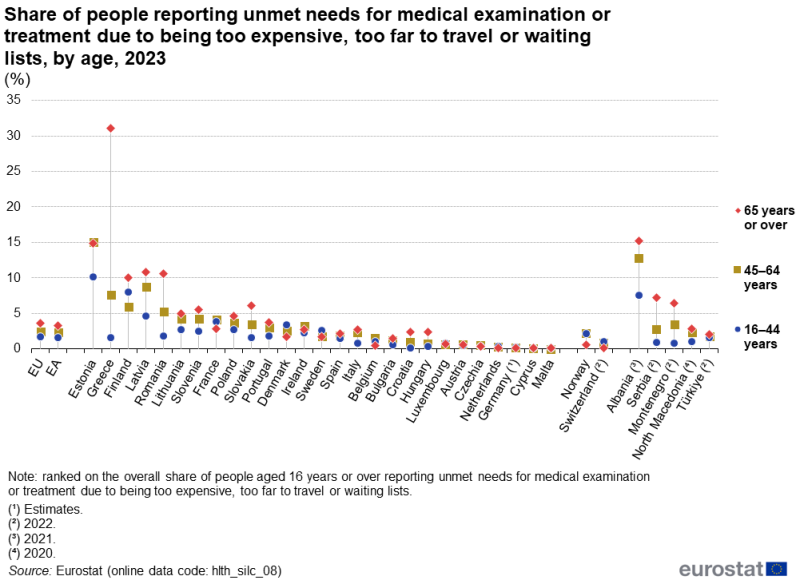
(%)
Source: Eurostat (hlth_silc_08)
In the EU, 1.7% of people aged 16 to 44 years reported unmet needs for medical care in 2023 due to it being too expensive, too far to travel or because of waiting lists, compared with 2.4% for people aged 45 to 64 years and 3.6% for people aged 65 years or over. In many of the EU countries, age was a factor linked to unmet needs for medical care due to these reasons, although there was not a universal pattern – see Figure 2.
In general, if EU countries had a relatively wide range – when analysed by age – in the share of people reporting unmet needs for medical care in 2023 due to treatment being too expensive, too far to travel or because of waiting lists, this was because the share was lowest for younger people and highest for older people. The clearest example of this pattern was observed in Greece, where the share for older people (65 years or over) was 29.5 percentage points (pp), higher than for the youngest age group (16 to 44 years). Where the range between the shares when analysed by age was relatively narrow, the pattern was less clear. In Denmark, the share of people reporting unmet needs for medical care was higher among people aged 16 to 44 years than it was for people aged 65 years or over (a difference of 1.7 pp); this pattern was repeated in Belgium, Germany, France, Luxembourg, the Netherlands and Sweden (although the differences were no more than 1.0 pp).
The share of people reporting unmet needs for medical care for reasons of expense was lowest among people with higher income

(%)
Source: Eurostat (hlth_silc_08)
Focusing only on expense, the most common reason for unmet needs for medical care in the EU, and its relation to levels of income, the likelihood of someone reporting an unmet need for this reason was inversely related to their income. In 2023, 2.2% of people aged 16 years or over in the 1st (lowest) income quintile (the 20% of people with the lowest income) in the EU reported unmet needs for medical care due to expense, compared with 1.6% in the 2nd quintile, 0.9% in the 3rd (middle) quintile, 0.4% in the 4th quintile and 0.2% in the 5th (highest) quintile (the 20% of people with the highest income).
Figure 3 shows the share of people reporting unmet needs for medical care due to expense and its relation to income: for reasons of readability, the figure shows the shares for the lowest, middle and highest quintiles only. In most of the EU countries, a similar pattern was observed to that in the EU as a whole: the highest shares of people with unmet needs for medical care due to expense were observed for the 1st income quintile and the lowest shares for the 5th income quintile, while the shares for the 3rd income quintile lay in between. There were several exceptions in 2023, nearly all of which concerned small differences (0.1 to 0.3 pp), often between low shares.
- In Lithuania, the share of people in the middle income quintile with unmet needs for medical care due to expense was lower than the corresponding share for people in the highest quintile.
- In Sweden, the share of people in the middle income quintile with unmet needs for medical care due to expense was also lower than the corresponding share for people in the highest quintile; furthermore, the shares of people in the lowest and highest income quintiles with unmet needs for medical care due to expense were equal.
- In Slovakia, the shares of people with unmet needs for medical care due to expense were the same for the lowest and middle income quintiles.
- In Czechia, Germany, Croatia, Cyprus, Malta, Austria and Slovenia, the shares of people with unmet needs for medical care due to expense were the same for the middle and highest income quintiles (in most cases, 0.0%).
- In the Netherlands, the shares of people with unmet needs for medical care due to expense were 0.0% for the lowest, middle and highest income quintiles.
The share of people reporting unmet needs for medical care for reasons of expense, too far to travel or waiting lists was lowest for people with higher levels of educational attainment
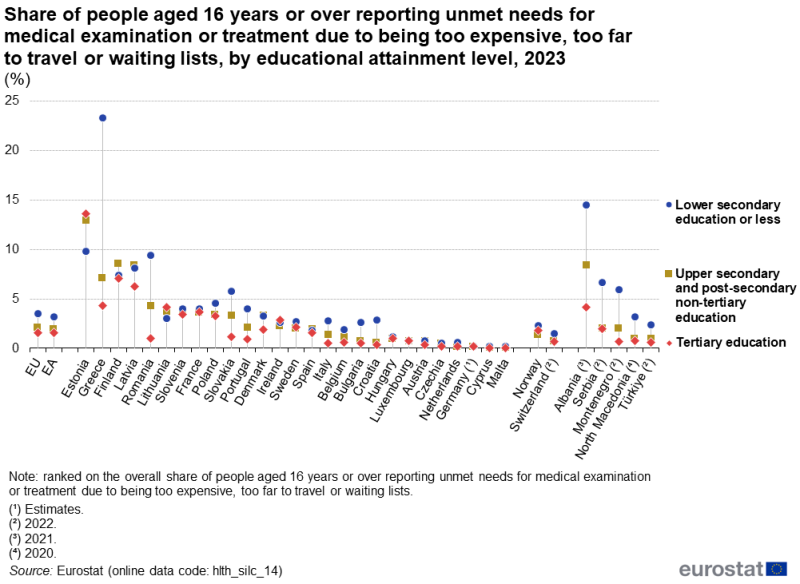
(%)
Source: Eurostat (hlth_silc_14)
The next analysis for the share of people reporting unmet needs for medical care due to expense, too far to travel or waiting lists is based on 3 groupings showing the highest level of educational attainment – see Figure 4.
In 2023, 1.6% of people aged 16 years or over in the EU having a tertiary level of educational attainment reported unmet needs for medical care due to it being too expensive, too far to travel or because of waiting lists; the corresponding shares were 2.1% for people having completed upper secondary or post-secondary non-tertiary education and 3.5% for people having completed, at most, lower secondary education.
- This general pattern of the highest share of people with unmet needs for medical care for the 3 specified reasons being among people with lower levels of educational attainment (no more than a lower secondary education) was observed in 17 of the EU countries; the differences were particularly apparent in Greece and Romania.
- In Spain, Latvia and Finland, the highest share of people with unmet needs for medical care for the 3 specified reasons was recorded among people with a medium level of educational attainment (upper secondary and post-secondary non-tertiary education).
- In Estonia, Ireland and Lithuania, the highest share of people with unmet needs for medical care for the 3 specified reasons was recorded among people with a higher level of educational attainment (tertiary education).
- In Germany, the highest share of people reporting unmet needs for medical care for the 3 specified reasons was jointly observed for all three levels of education.
- In Luxembourg, the highest share of people reporting unmet needs for medical care for the 3 specified reasons was jointly observed for people with lower or higher levels of educational attainment.
- In Czechia and Denmark, the highest share of people reporting unmet needs for medical care for the 3 specified reasons was jointly observed for people with lower or medium levels of educational attainment.
Among people with needs for medical care, the share reporting unmet needs due to expense, distance or waiting lists was highest among those at risk of poverty
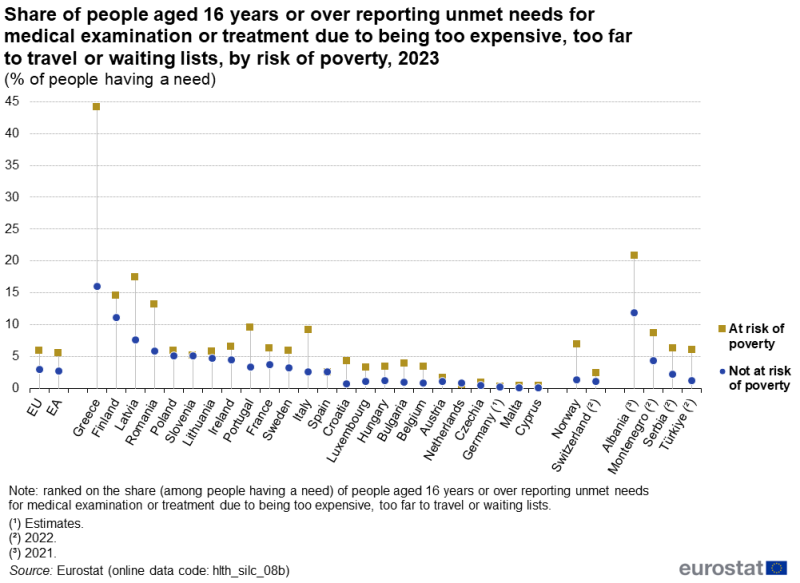
(% of people having a need)
Source: Eurostat (hlth_silc_08b)
This analysis focuses on the shares of people reporting unmet medical care needs – due to being too expensive, too far to travel or waiting lists – among people reporting needs for medical care (rather than among all people). Results are presented separately for people at risk of poverty or not at risk of poverty (see Figure 5).
Among this subpopulation of people aged 16 years or over in the EU who were at risk of poverty and had a need for medical care, 6.0% reported unmet needs for medical care due to it being too expensive, too far to travel or because of waiting lists. By contrast, 3.0% of those who were not at risk of poverty and had a need for medical care reported unmet medical needs.
This pattern, where the highest percentage of people with medical needs reporting unmet needs for the above mentioned reasons was observed among those at risk of poverty, in most EU countries.
- Spain and the Netherlands were exceptions, as they had lower shares among people at risk of poverty.
- Germany and Slovenia were also exceptions, as the shares were the same, regardless of the risk of poverty.
- Greece stood out with the highest disparity, as 44.1% of people at risk of poverty with needs for medical care reported unmet needs, 28.0 pp more than the share reported by those not at risk of poverty (16.1%). Other countries with notable differences between people at risk of poverty and people not at risk of poverty in terms of the shares experiencing unmet medical needs included Latvia (9.9 pp), Romania (7.3 pp), Italy (6.5 pp) and Portugal (6.2 pp).
Unmet needs for dental examination and treatment
In 2023, 4.7% of people in the EU had an unmet need for dental examination or treatment
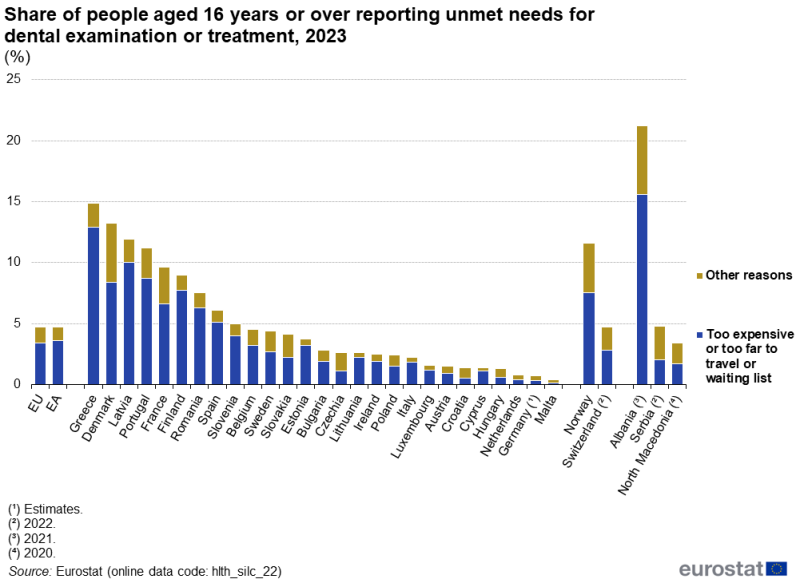
(%)
Source: Eurostat (hlth_silc_22)
In 2023, 4.7% of people aged 16 years or over in the EU reported that they had unmet needs for a dental examination or treatment (hereafter referred to as dental care); as such, the share of people with unmet needs was greater for dental care than for medical care. The share of people with unmet needs for dental care ranged from 0.4% in Malta, 0.7% in Germany and 0.8% in the Netherlands up to 11.2% in Portugal, 11.9% in Latvia and 13.2% in Denmark, with a peak of 14.9% in Greece.
If only reasons related to the organisation and functioning of health care services are considered – too expensive, too far to travel or waiting lists – 3.4% of people aged 16 years or over in the EU reported they had unmet needs. This share ranged from less than 1.0% in Malta, Germany, the Netherlands, Croatia, Hungary and Austria up to 10.0% in Latvia and 12.9% in Greece – see Figure 6.
Being too expensive was by far the most common reason for unmet dental care
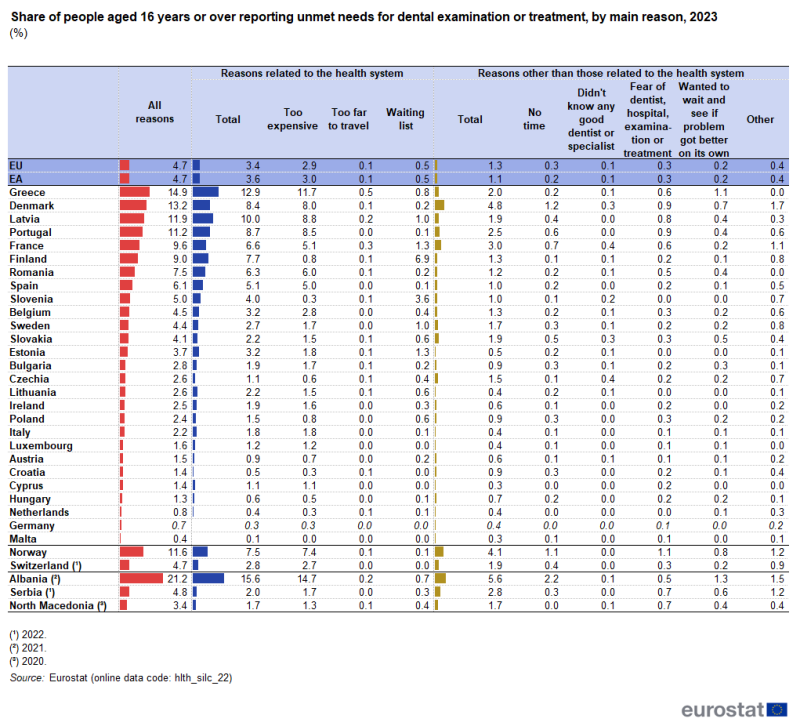
(%)
Source: Eurostat (hlth_silc_22)
In 2023, the most common reason for unmet needs for dental care in the EU was being too expensive: 2.9% of people aged 16 years or over reported unmet needs for this reason, which was approximately three fifths of all reasons – see Table 2. After expense, the next most common reasons reported for unmet needs for dental care were waiting lists (0.5% of people), fear (0.3%) and a lack of time (also 0.3%). Less common reasons included wanting to wait and see if the problem got better on its own (0.2%), that it was too far to travel (0.1%) or the respondent did not know a good dentist or specialist (also 0.1%). Aside from the specified main reasons, 0.4% of people indicated another (unspecified) reason for an unmet need for dental care.
The expense of dental care was the most common specific reason for unmet needs for dental care in 2023 in 23 of the 27 EU countries. In Romania, Italy and Spain, at least four fifths of all people with an unmet need for dental care said that the main reason was because of expense. There were 4 exceptions among the EU countries where expense was not the single most common main reason for unmet needs for dental care in 2023.
- In Croatia, equal shares were recorded for expense and a lack of time.
- A waiting list hindering dental care was the most common specific reason given for unmet needs for dental care in Finland and Slovenia, reported by approximately three quarters of the people with an unmet need for dental care.
- In Malta, a very low share of people reported unmet needs for dental care, with equal shares for a lack of time and fear.
Unmet needs for dental care due to expense, too far to travel or waiting lists were most often reported by people aged 45 to 64 years

(%)
Source: Eurostat (hlth_silc_22)
In the EU, 4.1% of people aged 45 to 64 years reported unmet needs for dental care due to expense, too far to travel or waiting lists in 2023. This was higher than the corresponding shares for younger people (3.0%; aged 16 to 44 years) or older people (3.2%; 65 years or over) – see Figure 7.
- In 16 EU countries, people aged 45 to 64 years were most likely to report unmet needs for dental care due to expense, too far to travel or waiting lists.
- In Finland, people aged 16 to 44 years or aged 45 to 64 years were jointly most likely to report unmet needs for dental care due to expense, too far to travel or waiting lists.
- In Bulgaria, Greece, Croatia, Malta, Romania, Slovenia and Slovakia, people in the oldest age group (aged 65 years or over) were most likely to report unmet needs for dental care due to expense, too far to travel or waiting lists; in all of these EU countries, the share was lowest for people aged 16 to 44 years.
- In Denmark, Ireland and Luxembourg, people in the youngest age group (aged 16 to 44 years) were most likely to report unmet needs for dental care due to expense, too far to travel or waiting lists; in all 3 of these EU countries, the share was lowest for people aged 65 years or over.
Unmet needs for dental care due to expense, too far to travel or waiting lists, were more often reported among people at risk of poverty
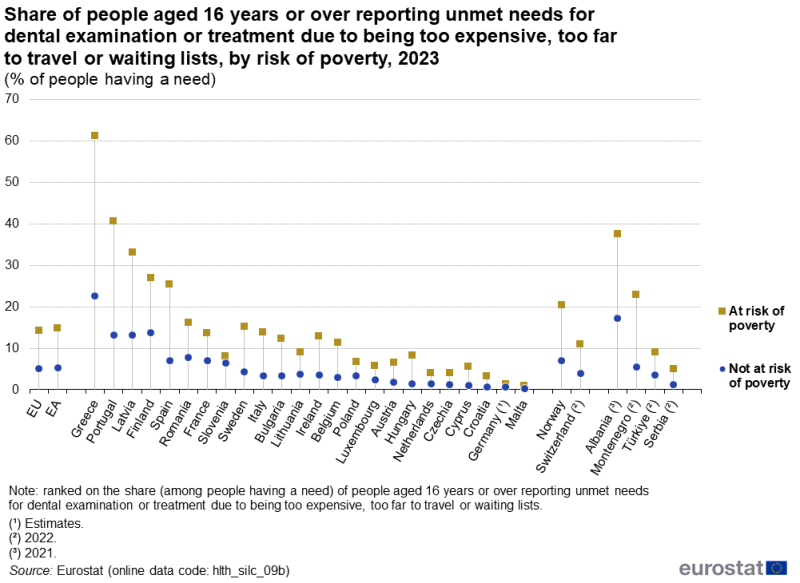
(% of people having a need)
Source: Eurostat (hlth_silc_09b)
Finally, Figure 8 presents the shares of people aged 16 years or over reporting unmet dental care needs – due to being too expensive, too far to travel or waiting lists – among people reporting needs for dental care (rather than among all people). Results are presented separately for people at risk of poverty or not at risk of poverty.
Among this subpopulation of people aged 16 years or over in the EU who were not at risk of poverty and had needs for dental care, the share who reported unmet needs due to being too expensive, too far to travel or waiting lists in 2023 was 5.1%, while it was significantly higher, at 14.3%, for those at risk of poverty.
- This pattern, where the highest percentage of people reporting unmet needs for dental care was observed among people at risk of poverty in all EU countries.
- The most significant contrast in reporting unmet needs for dental care due to being too expensive, too far to travel or waiting lists was observed in Greece, where 61.2% of people at risk of poverty reported such unmet needs compared with 22.6% among those not at risk, a gap of 38.6 pp. Notable differences were also observed in Portugal (27.5 pp), Latvia (20.1 pp) and Spain (18.3 pp).
- By contrast, Malta, and Germany recorded the narrowest gaps between the rates of unmet dental care needs among people at risk of poverty and those not at risk of poverty, with differences of 0.7 and 0.8 pp, respectively.
Source data for tables and graphs
Data sources
EU-SILC is the source of comparative statistics on income distribution and social inclusion in the EU. It provides annual data for the EU countries as well as some EFTA and enlargement countries on income, poverty, social exclusion and other aspects of living conditions.
The reference population for EU-SILC is limited to private households and their current members residing in the territory of the surveying country at the time of data collection. People living in collective households and institutions are generally excluded from the reference population. All household members are surveyed, but only those aged 16 years or over are interviewed.
Questions included in EU-SILC on medical and dental examination or treatment refer to a person’s own assessment of whether they needed examination or treatment for the specific types of health care (medical and dental) in the previous 12 months but did not receive it or did not seek it.
The source is documented in more detail in this background article, which provides information on the scope of the data, its legal basis, the methodology employed, as well as related concepts and definitions.
Limitations of the data
All of the indicators presented in this article are derived from self-reported data so they are, to a certain extent, affected by respondents’ subjective perception as well as by their social and cultural background. Despite their subjective nature, the statistics that are presented are considered to be relevant and reliable estimators of the health status of people as well as good predictors of health care needs; they are also valuable for trend analyses and for measuring socioeconomic disparities.
EU-SILC does not cover the institutionalised population, for example, people living in health and social care institutions whose health status is likely to be worse than that of people living in private households. It is therefore likely that to some degree, this data source under-estimates the share of people with health problems. By contrast, the exclusion of health and social care institutions, where medical care is likely to be readily available, may lead to an over-estimation of unmet needs for health care.
Another factor that may influence the results shown is the different organisation of health care services, be that nationally or locally. Furthermore, the indicators presented are not age-standardised and thus reflect the current national age structures. Finally, despite substantial and continuous efforts for harmonisation, the implementation of EU-SILC is organised nationally, which may impact on the results presented, for example, due to differences in the formulation of questions or their precise coverage.
Context
Good health is an asset in itself. It is not only of value to the individual as a major determinant of quality of life, well-being and social participation, but it also contributes to general social and economic growth. Many factors influence the health status of people, and these can be addressed by health and other policies regionally, nationally or across the EU.
Barriers to accessing health care include cost, distance, waiting times, lack of cultural sensitivities and discrimination. For non-native speakers, language can be an obstacle for those seeking to access services, while barriers to health care may also result from poor understanding or a lack of knowledge with respect to a patient’s rights and the administrative practices and requirements of health systems.
A European Commission Communication Towards social investment for growth and cohesion (COM(2013) 83 final) and its accompanying document on Investing in health (SWD(2013) 43) highlight the need to invest in sustainable health systems which can improve cohesion and boost economic growth by reducing health inequalities, enabling people to remain active longer and in better health. The EU4Health programme 2021–2027 – a vision for a healthier European Union sets out 4 general objectives
- improving and fostering health
- protecting people
- access to medicinal products, medical devices and crisis-relevant products (ensuring that these products are accessible, available and affordable)
- strengthening health systems.
Investment designed to reduce health inequalities should contribute to increased social cohesion and may help break the spiral of poor health that both contributes to and results from poverty and exclusion. Health inequalities represent a considerable burden both in terms of their effect on an individual’s health, as well as productivity losses and costs associated with social protection systems.
An indicator on the equality of access to health care service, defined as the total self-reported unmet need for medical care for the reasons of financial barriers, waiting times and too far to travel, is included in the health services chapter of the European core health indicators (ECHI).
Explore further
Other articles
Online publications
Healthcare
- Physicians
- Dentists, pharmacists and physiotherapists
- Hospital discharges and length of stay
- Consultations
- Healthcare expenditure
Methodology
General health statistics articles
Database
- Health (hlth), see
- Health care (hlth_care)
- Unmet needs for health care (hlth_unm)
Thematic section
Publications
Methodology
- Income and living conditions (ilc) (SIMS metadata file)
- Health variables of EU-SILC (ESMS metadata file – hlth_silc_01_esms)
- EU statistics on income and living conditions (EU-SILC) methodology
- Health variables in EU-SILC
